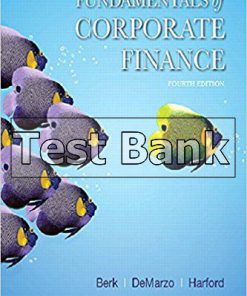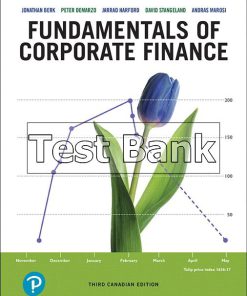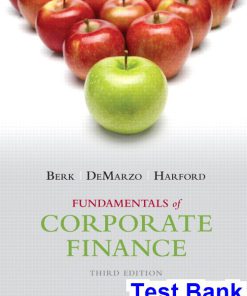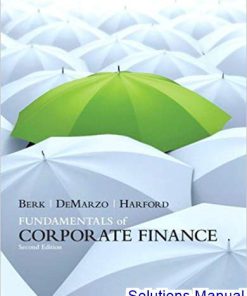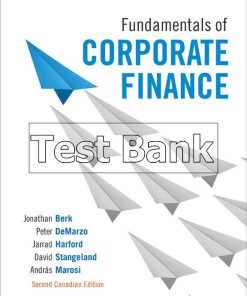Fundamentals of Corporate Finance 2nd Edition Berk Test Bank
$50.00 Original price was: $50.00.$26.50Current price is: $26.50.
Fundamentals of Corporate Finance 2nd Edition Berk Test Bank.
Fundamentals of Corporate Finance 2nd Edition Berk Test Bank

Product details:
- ISBN-10 : 0470933267
- ISBN-13 : 978-0470933268
- Author: Robert Parrino
Fundamentals of Corporate Finance, 2nd Edition offers an innovative integration of conceptual understanding and problem-solving… of intuition and decision-making… of the authors’ industry and classroom/research experience…with current real-world examples and online practice. Authors Robert Parrino, David Kidwell, and Thomas Bates believe that students who understand the intuition underlying the basic concepts of finance are better able to develop the critical judgments necessary to apply financial tools in real decision- making situations. Their text develops intuitive thinking while simultaneously helping students develop problem solving and computational skills. It then shows students how to apply intuition and analytical skills to decision making while integrating it all with valuation and building shareholder value.
Table contents:
Chapter 1 Introduction to Corporate Finance 1 1.1 Corporate Finance and the Financial Manager 2 What Is Corporate Finance? 2 The Financial Manager 2 Financial Management Decisions 2 Capital Budgeting 2 Capital Structure 3 Working Capital Management 4 Conclusion 4 1.2 Forms of Business Organization 4 Sole Proprietorship 5 Partnership 5 Corporation 6 A Corporation by Another Name . . . 7 1.3 The Goal of Financial Management 8 Possible Goals 8 The Goal of Financial Management 9 A More General Goal 9 1.4 The Agency Problem and Control of the Corporation 10 Agency Relationships 10 Management Goals 10 Do Managers Act in the Stockholders? Interests? 12 Managerial Compensation 12 Control of the Firm 13 Conclusion 14 Stakeholders 14 1.5 Financial Markets and the Corporation 14 Cash Flows to and from the Firm 14 Primary versus Secondary Markets 15 Primary Markets 15 Secondary Markets 16 1.6 Summary and Conclusions 17 Chapter 2 Financial Statements, Taxes, and Cash Flow 20 2.1 The Balance Sheet 21 Assets: The Left-Hand Side 21 Liabilities and Owners? Equity: The Right-Hand Side 21 >> Net Working Capital 22 Liquidity 23 Debt versus Equity 24 Market Value versus Book Value 24 2.2 The Income Statement 25 GAAP and the Income Statement 26 Noncash Items 27 Time and Costs 27 2.3 Taxes 29 Corporate Tax Rates 29 Average versus Marginal Tax Rates 29 2.4 Cash Flow 31 Cash Flow from Assets 32 Operating Cash Flow 32 Capital Spending 33 Change in Net Working Capital 33 Conclusion 34 A Note on "Free" Cash Flow 34 Cash Flow to Creditors and Stockholders 34 Cash Flow to Creditors 34 Cash Flow to Stockholders 35 An Example: Cash Flows for Dole Cola 36 Operating Cash Flow 36 Net Capital Spending 37 Change in NWC and Cash Flow from Assets 37 Cash Flow to Stockholders and Creditors 38 2.5 Summary and Conclusions 39 PART TWO Financial Statements and Long-Term Financial Planning Chapter 3 Working with Financial Statements 48 3.1 Cash Flow and Financial Statements: A Closer Look 49 Sources and Uses of Cash 49 The Statement of Cash Flows 51 3.2 Standardized Financial Statements 53 Common-Size Statements 53 Common-Size Balance Sheets 54 Common-Size Income Statements 54 Common-Size Statements of Cash Flows 55 Common?Base Year Financial Statements: Trend Analysis 55 Combined Common-Size and Base-Year Analysis 56 ros91593_fm.qxd 12/20/04 22:06 Page xxxiii 3.3 Ratio Analysis 56 Short-Term Solvency, or Liquidity, Measures 57 Current Ratio 58 The Quick (or Acid-Test) Ratio 59 Other Liquidity Ratios 59 Long-Term Solvency Measures 60 Total Debt Ratio 60 A Brief Digression: Total Capitalization versus Total Assets 61 Times Interest Earned 61 Cash Coverage 61 Asset Management, or Turnover, Measures 62 Inventory Turnover and Days? Sales in Inventory 62 Receivables Turnover and Days? Sales in Receivables 63 Asset Turnover Ratios 64 Profitability Measures 64 Profit Margin 65 Return on Assets 65 Return on Equity 65 Market Value Measures 66 Price-Earnings Ratio 66 Market-to-Book Ratio 67 Conclusion 68 3.4 The Du Pont Identity 68 A Closer Look at ROE 68 An Expanded Du Pont Analysis 70 3.5 Using Financial Statement Information 71 Why Evaluate Financial Statements? 72 Internal Uses 72 External Uses 72 Choosing a Benchmark 72 Time-Trend Analysis 72 Peer Group Analysis 73 Problems with Financial Statement Analysis 77 3.6 Summary and Conclusions 78 Chapter 4 Long-Term Financial Planning and Growth 90 4.1 What Is Financial Planning? 91 Growth as a Financial Management Goal 91 Dimensions of Financial Planning 92 What Can Planning Acccomplish? 93 Examining Interactions 93 Exploring Options 93 Avoiding Surprises 93 Ensuring Feasibility and Internal Consistency 93 Conclusion 94 4.2 Financial Planning Models: A First Look 94 A Financial Planning Model:The Ingredients 94 Sales Forecast 94 Pro Forma Statements 94 Asset Requirements 95 Financial Requirements 95 The Plug 95 Economic Assumptions 95 A Simple Financial Planning Model 95 4.3 The Percentage of Sales Approach 97 The Income Statement 97 The Balance Sheet 98 A Particular Scenario 99 An Alternative Scenario 100 4.4 External Financing and Growth 102 EFN and Growth 104 Financial Policy and Growth 106 The Internal Growth Rate 106 The Sustainable Growth Rate 107 Determinants of Growth 108 A Note on Sustainable Growth Rate Calculations 109 4.5 Some Caveats Regarding Financial Planning Models 111 4.6 Summary and Conclusions 111 PART THREE Valuation of Future Cash Flows
People also search:
fundamentals of corporate finance 2nd edition
fundamentals of corporate finance asia global 2nd edition ebook
fundamentals of corporate finance asia global 2nd edition
fundamentals of corporate finance asia global 2nd edition pdf
what are the fundamentals of finance
what are the four areas of corporate finance
Instant download after Payment is complete
You may also like…
Solutions Manual
Fundamentals Of Corporate Finance 2nd Edition Berk Solutions Manual




